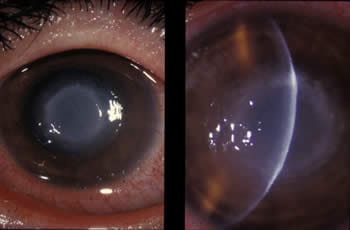Basics of Parasitic/Amebic Keratitis
Acanthamoeba Keratitis (AK)
What is Acanthamoeba keratitis?

Eye infection from Acanthamoeba.
Acanthamoeba keratitis, or AK, is a rare but serious infection of the eye that can cause permanent vision loss or blindness 1. This infection is caused by a tiny ameba (single-celled living organism) called Acanthamoeba. Acanthamoeba causes Acanthamoeba keratitis when it infects the cornea, the clear dome that covers the colored part of the eye 1.
What are the symptoms of Acanthamoeba keratitis?
Symptoms of AK include: 2
- Sensation of something in the eye
- Eye pain
- Eye redness
- Blurred vision
- Sensitivity to light
- Excessive tearing
If you experience any of these symptoms, remove your contact lenses (if you wear them) and call your eye doctor right away. AK is a rare condition, but if left untreated it can result in vision loss or blindness 3.
Where is Acanthamoeba found?
Acanthamoeba is very common in nature and can be found in bodies of water (for example, lakes and oceans) and soil 4. It can also be found in tap water, heating, ventilating, and air conditioning units, and whirlpools 4. Infection of the eye occurs when the Acanthamoeba organisms contained in water or contact lens solution enter the eye through small scrapes that can be caused by contact lens wear or other minor eye injuries 5, 6. The Acanthamoeba organism has to make contact directly with the eyes in order to cause AK, so this type of corneal infection cannot occur from drinking or inhaling water that has this ameba in it 5-7. AK cannot be spread from person to person.
What puts people at risk for Acanthamoeba keratitis?
In the United States, an estimated 85% of AK cases occur in contact lens wearers 8, 9. For people who wear contact lenses, the risk of getting Acanthamoeba keratitis is higher if they:
- Do not store or handle contact lenses properly. This can include not washing hands before touching contact lenses, not rubbing and rinsing lenses after taking them out, and not storing them in the recommended contact lens solution 10, 11.
- Do not disinfect contact lenses properly. This can include using tap water to clean the lenses or lens case, or adding fresh solution to existing used solution in the case instead of using only fresh solution when storing contact lenses 9, 11-13.
- Swim, use a hot tub, or shower while wearing lenses 14-16.
- Have a history of trauma to the cornea, such as a previous eye injury 7, 17.
In 2007, CDC investigated a nationwide outbreak of Acanthamoeba keratitis which led to the recall of a specific type of contact lens solution from the market 11, 13. Another nationwide outbreak in 2011 pointed to inadequate hygiene among contact lens wearers, in addition to water exposure and “topping off”—adding fresh solution to old solution—in the contact case.
How is Acanthamoeba keratitis diagnosed?
Early diagnosis is important because early treatment can prevent AK infections from becoming more severe 3. The infection is usually diagnosed by an eye doctor based on symptoms, lab results from a scraping of the eye, and/or through a close-up eye exam that allows the eye doctor to see the ameba 2.
How is Acanthamoeba keratitis treated?
AK can be difficult to treat, and the best treatment regimen for each patient should be determined by an eye doctor. AK usually requires aggressive medical and surgical treatment 2, 18. If you think that your eye may be infected with Acanthamoeba, see an eye doctor immediately.
How do you prevent Acanthamoeba keratitis?
Follow these tips to keep your eyes healthy while wearing contact lenses. Your daily habits, your contact lenses and supplies, and your eye doctor are all important.
- CDC. Acanthamoeba
- Prevent Blindness. Acanthamoeba keratitis and contact lenses